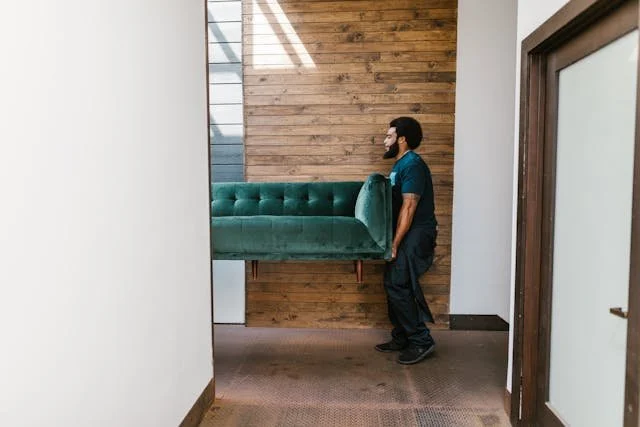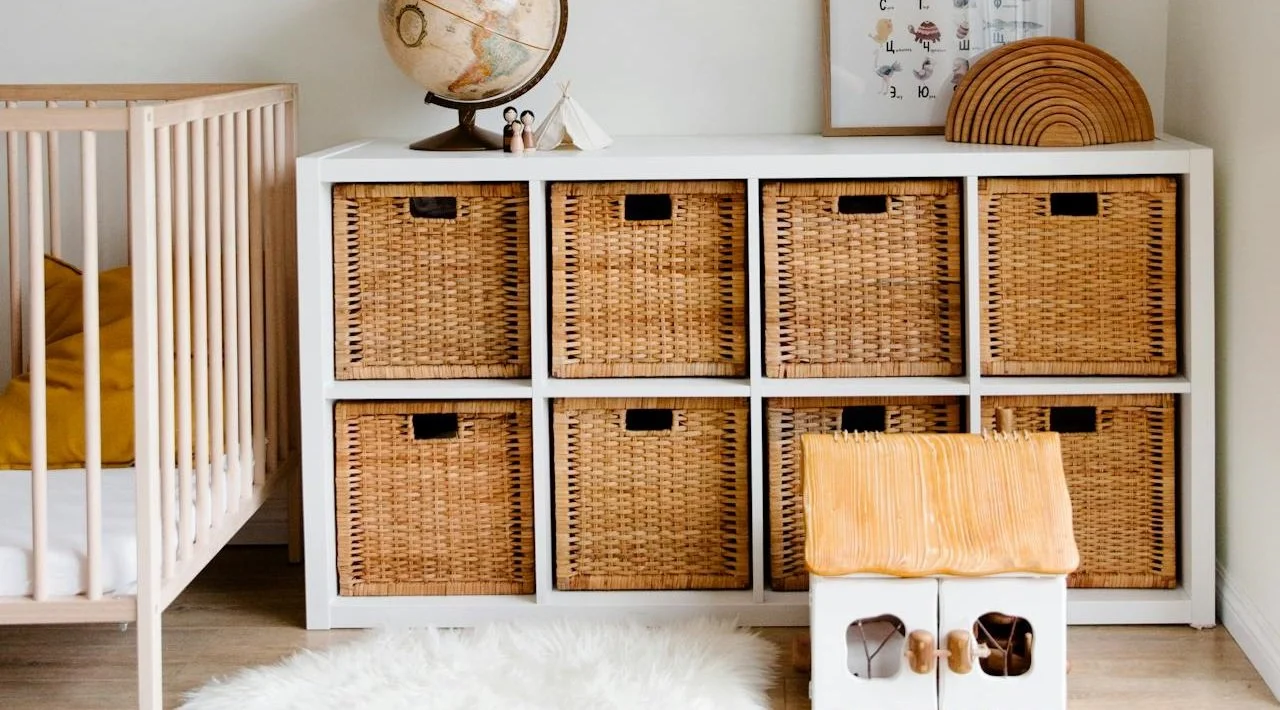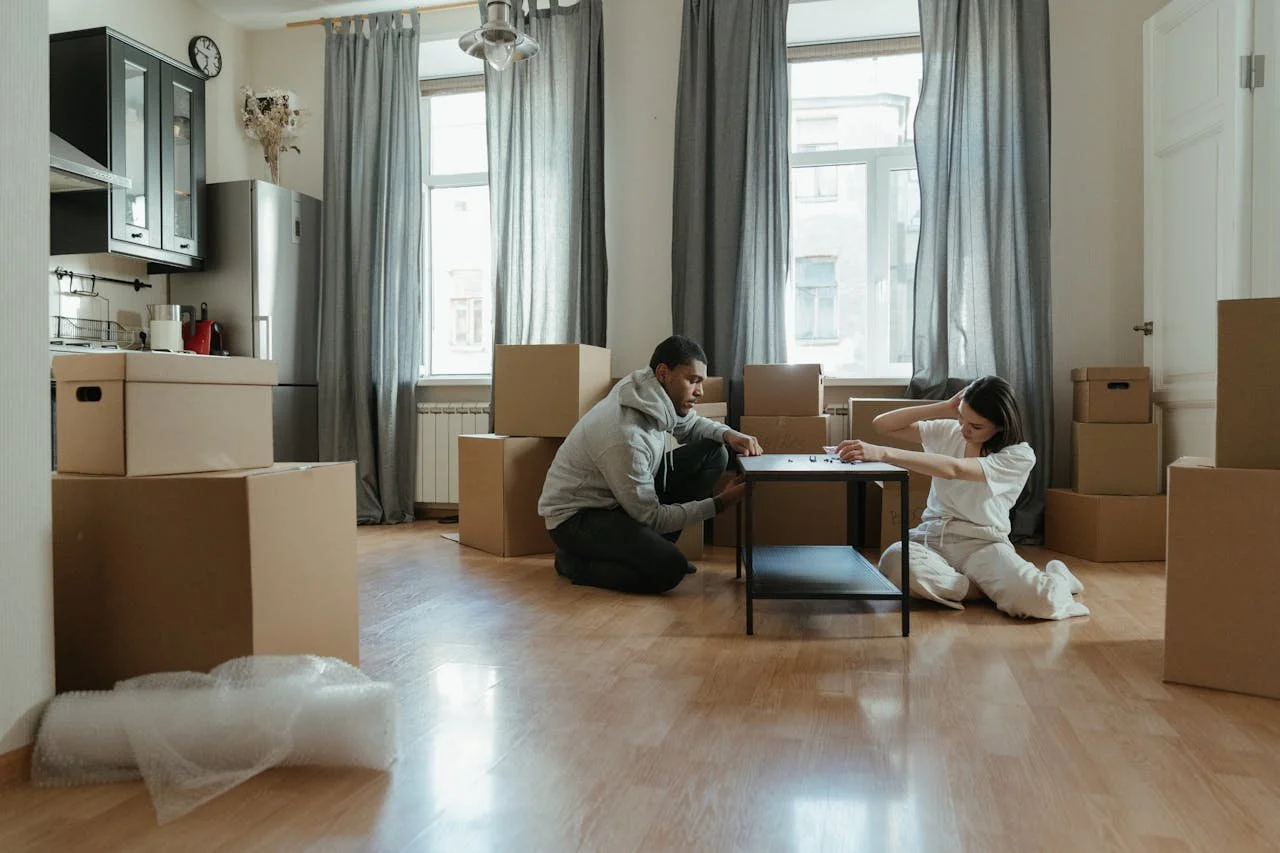
A resource for those seeking information on organizing and transforming spaces.
The Post-Move Rituals That Create Instant Comfort and Order
Create comfort fast with practical post-move rituals that build order, reduce stress, and help your new home feel settled right away.
A new home feels fresh and full of potential, yet the first hours can feel chaotic. Simple post-move rituals help reduce stress, build order, and set the tone for calm daily living. These steps guide your focus, make unpacking easier, support clear decisions, help you settle, and make each room feel functional from the start.
Start With a Reset Moment
Take a short pause before unpacking. A brief walk-through helps you see the layout without boxes blocking your view. This moment gives you clarity and supports better decisions about placement, storage, and flow. You also begin working with intention rather than jumping between tasks.
Why Post-Move Rituals Matter for Immediate Calm
Your move may be complete, but your home still needs structure. Early habits create comfort, spark routine, and give each space purpose. These post-move rituals also prevent clutter from forming during the unpacking stage and help you avoid common mistakes everyone makes in the first few days. Practical steps, clear priorities, and small wins help you settle with confidence.
Set Up Your Primary Comfort Zones First
Focus on spaces that support daily habits. These include the bedroom, bathroom, kitchen, and entry area. Each one influences your routine, energy, and comfort.
Bedroom: Make the bed, place lamps, and choose a spot for the clothes you need tomorrow.
Bathroom: Stock toiletries, towels, and basic cleaning items.
Kitchen: Set up a small meal station with dishes, utensils, and simple foods.
Entry Area: Place hooks, a shoe mat, and a small tray for keys and small items.
Post-Move Rituals That Bring Quick Order and Focus
Your list of post-move rituals should feel simple and practical. Each task brings a quick sense of order without overwhelming you. Short tasks help you build momentum and keep your focus on progress, not perfection.
Create a One-Day Unpacking Plan
Create a one-day unpacking plan that feels light and manageable. You don’t need to finish everything in a single day—your only goal is to give yourself a sense of structure and purpose. Begin by unpacking the essentials so your new space feels functional right away. Break larger tasks into simple 20-minute sessions to stay focused without feeling overwhelmed. Keep a small bin nearby for random items you’re not ready to sort; you can find their proper place later. Use a timer to prevent fatigue, and take short breaks to reset your mind and keep your energy steady as you settle in.
Use Simple Storage Solutions to Lift the Space
Using simple storage solutions can quickly lift the look and feel of your space by bringing order where it matters most. Start by adding drawer dividers to keep small items from getting lost in the clutter, then label your bins so everything has a clear home. Baskets help contain loose items that tend to scatter, while grouping belongings by purpose makes your daily routine easier to navigate. Finally, place the things you use most often within easy reach, giving your space a sense of calm efficiency that supports both comfort and productivity.
Clean as You Unpack
Wipe shelves, counters, and drawers before placing items. This action prevents dust build-up and gives you a clean foundation. A fresh home supports better productivity, relaxation, and focus.
Keep Your Surfaces Clear
Tables and counters attract clutter. Clear surfaces make the home look ready, open, and peaceful. After unpacking each box, check the nearest surface. Put items in their category bins right away. It is a small step with a big payoff.
Smart Strategies for Better Setup
Mindfulness before a move shapes how smoothly you settle in later. When you stay aware of what you pack, why you pack it, and how it fits into your new space, you create a calmer and more organized transition. This mindset naturally leads to smarter decisions about what to keep, how to group items, and where they will eventually belong. As you work through your move tasks, you can use packing hacks that simplify unpacking and help you stay focused on steady progress. These techniques give you space to reflect and adjust your approach, which enables you to do it the right way while keeping momentum.
A thoughtful mid-process plan also encourages practical choices. Declutter before you pack so you don’t move items you no longer want. Create a packing plan that outlines room-by-room priorities. Use quality packing materials to protect your belongings and reduce stress later. These small steps support clear sorting, faster setup, and smarter placement once you arrive. They work together to help you stay intentional, reduce overwhelm, and settle in with confidence.
Create Your Mid-Home Comfort Stations
Creating your mid-home comfort stations helps you stay balanced while you continue unpacking and settling in. Start with a small hydration and snack station where you keep water, light snacks, and a few plates within easy reach. Staying fueled supports better decisions and lowers stress as you move from task to task.
Also, add a simple relaxation corner with one chair, a lamp, and a calming touch like a soft blanket or candle—this becomes your quick reset space when you need a moment to breathe. Then designate a charging zone for all your cables, chargers, and power banks. Having one central spot prevents tangles, misplaced items, and unnecessary frustration. Together, these stations bring rhythm and comfort to your new home during the transition phase.
Create a Quick Daily Reset Routine
A quick daily reset routine can make your home feel calmer and more manageable while you unpack. By taking a few minutes each evening to put loose items in bins, clear the kitchen counters, and prepare your clothes for the next day, you create a sense of order that carries into the morning. Small habits like wiping the bathroom sink and placing boxes in the areas where they belong help keep clutter from building up and make each day of settling in feel a little easier. Over time, this simple routine supports a predictable, tidy environment that helps you feel more at home.
Make Your Entryway Functional Early
Make your entryway functional early because this small space sets the tone for the comfort and order of your entire home. Setting up a few key items right away—such as hooks for jackets and bags, a shoe mat to keep dirt contained, a small tray for keys, a dedicated bag holder, and a mirror for quick checks before heading out—creates an immediate sense of structure. This simple setup supports your daily routine, reduces clutter, and strengthens your feeling of control every time you walk through the door.
Calm And Comfort With Small Daily Habits
Settling into a new space feels easier when you make small choices that support comfort and clarity. Begin by refreshing the air and light—open the windows for a few minutes to clear out stale air, and experiment with different lighting setups until the room feels balanced. These tiny shifts help the space feel brighter and more grounded.
As you unpack, create a simple box-removal routine by breaking down each empty box and stacking it near the door for recycling. That keeps each room open, reduces visual clutter, and makes your progress easier to see. Finally, personalize one meaningful spot each day by placing a photo, plant, or favorite item somewhere you’ll notice it. This gentle habit brings warmth into your home and helps it feel lived-in long before everything is fully set up.
Stay Flexible and Adjust Your Systems
Your first setup may not be perfect, and that is normal. Adjust your systems as you become familiar with the flow of your home and how each room supports your routine. These post-move rituals help you refine each space and make your move more successful by showing you which items need better placement or easier access. Move items based on use frequency and comfort, and shift zones as your daily habits settle. Flexibility supports better long-term order and helps your home feel more efficient with each small change.
Building Comfort With Simple Post-Move Rituals
Your new home grows more comfortable each day. Clear habits, quick wins, and practical plans help you settle with ease. These post-move rituals turn boxes into organized spaces and new rooms into familiar places. With steady steps and simple systems, your home becomes a space that supports your daily comfort and personal rhythm.
How Senior Moving Services Differ Between The U.S. and Canada
Relocating during the golden years is more than just packing and moving boxes. It is an emotional transition that deserves patience, care, and the right support. Many seniors move to downsize, live closer to family, or settle into a retirement community. But what many families don’t realize is that senior moving services differ significantly between the United States and Canada.
We partnered with a relocation company for this post. The opinions in the post are honest. All reviews and opinions expressed in this post are based on our personal views. We are excited because we know you will love it.
Relocating during the golden years is more than just packing and moving boxes. It is an emotional transition that deserves patience, care, and the right support. Many seniors move to downsize, live closer to family, or settle into a retirement community. But what many families don’t realize is that senior moving services differ significantly between the United States and Canada.
From how moves are organized to the kind of support offered, both countries have their own systems designed to help older adults relocate comfortably. Let’s explore how these differences shape the moving experience for seniors on both sides of the border.
How Senior Moves Are Managed In Each Country
In both nations, senior movers share the same goal — helping older adults move safely and with dignity. Yet, their approach differs in structure and service model.
In the United States, most companies follow the Senior Move Management system. Certified professionals plan every detail, from sorting and packing to arranging estate sales and setting up the new home. These specialists often belong to professional associations like NASMM (National Association of Senior Move Managers), which ensures they follow strict training and care standards.
In Canada, the concept is more community-oriented. Many full-service movers include senior relocation as part of their broader offerings. Instead of relying on independent move managers, senior movers Ottawa and other Canadian cities provide complete solutions that combine packing, junk removal, furniture setup, and storage under one coordinated plan. The focus is on trust, affordability, and building long-term relationships within the community.
Regulations and Safety Standards You Should Know
The difference between the two countries also appears in their moving regulations.
In the United States, interstate senior moves are regulated by the Federal Motor Carrier Safety Administration (FMCSA). Movers must meet federal guidelines for licensing, insurance, and cargo protection. This gives seniors added peace of mind when moving between states.
In Canada, moving services are governed provincially rather than nationally. For example, Ontario and British Columbia have their own consumer protection rules. While this system allows flexibility, it also means that standards may vary between provinces. However, Canadian movers often make up for this with stronger personal attention and local accountability that seniors appreciate.
Emotional and Family Support During The Move
A senior move is not just physical work it’s an emotional journey. Both countries recognize this but handle it differently.
In the U.S., senior move managers often work with caregivers, therapists, and senior living advisors. They aim to reduce emotional stress by involving family members in the process and helping seniors feel settled in their new space.
In Canada, family plays a more active role. Relatives often take the lead, with movers assisting wherever needed. Some moving companies collaborate with local retirement homes or real estate agents to provide comprehensive support. The result is a move that feels personal, respectful, and community-driven.
Comparing Costs and Flexibility
Pricing also differs between the two systems.
In the United States, hiring a certified senior move manager can cost between $1,500 and $5,000, depending on the scope of work. Additional costs may apply for transportation, storage, or furniture assembly.
In Canada, the approach is more bundled and transparent. Senior moving packages typically range from $1,000 to $3,000 for local relocations, often including packing, transport, and setup. Many of the top movers in Ottawa even offer flexible payment options or senior discounts to make the process smoother for retirees on fixed incomes.
Final Thoughts: Choosing The Right Approach
Whether you are in the U.S. or Canada, moving for seniors is about comfort, safety, and compassion. Understanding how each country’s system works can help families plan better and make informed decisions.
The U.S. approach offers a structured process led by certified managers, ideal for families wanting professional oversight. The Canadian approach focuses more on community, trust, and family involvement, which creates a warmer and more personal moving experience.
In the end, what matters most is ensuring that every senior feels supported, respected, and at peace as they begin a new chapter in life.
How to Divide Moving Tasks Between Family Members
Learn how to divide moving tasks between family members with easy steps, teamwork tips, and smart planning for a smooth, happy move.
Moving can be stressful, but it doesn’t have to feel impossible when everyone helps. The key is knowing how to divide moving tasks between family members so each person contributes fairly. When every family member understands their role, the move becomes smoother, quicker, and less chaotic. Whether you live with adults, teenagers, or young children, everyone can play a part in making moving day a success.
Start With a Family Meeting
Before you begin packing, prepare the whole family for the move in advance. Gather everyone for a quick discussion. Talk about the moving date, what needs to be done, and who’s best at certain tasks. Encourage open conversation and allow each person to share their ideas. This step avoids confusion later and builds a sense of teamwork. A shared list or digital calendar can help you stay on track. Use bright colors or stickers to make it fun, especially for kids. When everyone feels heard, they’re more likely to stay motivated.
Create a Moving Task List That Works
To divide moving tasks effectively, write everything down. A written list helps you see the full picture and makes planning easier. Break large chores into smaller, manageable steps. Instead of writing “pack kitchen,” list “wrap glassware,” “box dishes,” and “label pantry items.” Assign tasks based on each person’s strengths. Adults can handle logistics and heavy lifting, while teens organize clothes or electronics. Younger children can sort toys or choose which books to donate. This approach keeps everyone busy, builds responsibility, and speeds things up.
Assign Tasks Based on Age and Strengths
Give everyone a role that fits their abilities. Kids can handle lightweight jobs, teens can manage moderate ones, and adults take on complex or heavier responsibilities. This keeps things safe and fair. If your kids are old enough, they can help you unpack small boxes in their rooms once you move in. That way, they take ownership of their new space and feel proud of helping. Teens might be great at setting up devices or handling pets during the move. When everyone contributes, you’ll be surprised how quickly progress happens.
Keep the Momentum Going With Smart Planning
Long moves can drag on, but visual progress helps maintain your relocation organized. Hang a chart or checklist on the wall. Each time a task is finished, check it off. It’s simple but satisfying. Reward progress with small treats—a snack break, takeout night, or a short movie. These moments keep energy up and spirits high. Also, plan rest times. Fatigue can make mistakes more likely, so schedule pauses for water and food. When everyone stays energized, the process flows better.
Label and Organize Like a Pro
Labeling is an underrated lifesaver. Use color-coded boxes—blue for bedrooms, red for kitchen, green for living room. Write what’s inside each box clearly. This way, everyone knows where to put items without asking. Label boxes by room instead of person, which saves confusion later. You can even number them and keep a quick reference list on your phone. If you need the coffee maker on day one, you’ll know exactly where it is. The organization reduces frustration and keeps things moving smoothly.
Make It Fun for Everyone
When you divide moving tasks, remember that attitude matters. Turn packing into a game. Set a timer and see who can wrap items fastest (without breaking anything). Play music while packing—it keeps the energy light. Create small challenges like “find five items to donate” or “label five boxes in ten minutes.” Kids love games, and it turns chores into fun. Staying positive helps everyone stay calm, even when the to-do list feels long. Moving is emotional, but it’s also exciting. Treat it as the beginning of something new rather than just a big job.
Tackle Moving Day With Confidence
When moving day arrives, have a plan. Assign one person to coordinate—someone who can answer quick questions and make final calls. This avoids confusion about what’s loaded or left behind. Keep the house organized by stages: packed rooms, half-packed rooms, and done rooms. Give children small, safe tasks so they feel involved. Make sure everyone knows the safety plan, especially when movers or trucks are around. Prepare easy snacks, water bottles, and a few portable chargers. These simple things can prevent last-minute stress.
Stay Calm and Handle the Unexpected
Even the best plan can hit bumps. A box might break, a storm might start, or traffic might slow everything down. Try to stay calm and adjust. Pack a “moving essentials” bag with important items to ensure a smooth transition—medications, phone chargers, documents, and a change of clothes. That way, you’re covered no matter what happens. Encourage family members to help each other when small problems arise. A calm, cooperative attitude keeps things moving forward. Remember, no move is perfect, but flexibility makes a big difference.
Unpack Together for a Smooth Start
Once you arrive, unpacking can seem endless. Don’t rush; focus on the most used spaces first—the kitchen, bedrooms, and bathrooms. Assign one person to each space and keep the teamwork going. Adults can handle fragile items, while kids organize their toys or books. Working together keeps energy high and makes the new house feel like home faster. Turn on some music, open the windows, and keep boxes moving until everything finds its place. A few days of teamwork will make your new space feel settled quickly.
Conclusion: Divide Moving Tasks to Move Happily
When you divide moving tasks between family members, you turn a challenging event into a family project. Everyone contributes something valuable. Adults guide, teens organize, and kids participate proudly. It’s more than just efficiency—it’s teamwork in action. By planning, labeling, organizing, and keeping a positive attitude, your family can turn a stressful move into an enjoyable shared experience. Moving teaches patience, cooperation, and flexibility. You’ll not only end up in a new home but also create memories of working together. In the end, every box packed and unpacked with shared effort makes your new start brighter. With balance, laughter, and teamwork, you’ll move forward smoothly—and happily.
5 Essential Tips for a Smooth Relocation with NJ Movers
Moving to a new home is one of those rare moments when anticipation meets reality in the best possible way. You walk through that door for the first time, and suddenly all those weeks of planning actually make sense. This is it – your new chapter.
We partnered with a moving company for this post. The opinions in the post are honest. All reviews and opinions expressed in this post are based on our personal views. We are excited because we know you will love it.
Moving to a new home is one of those rare moments when anticipation meets reality in the best possible way. You walk through that door for the first time, and suddenly all those weeks of planning actually make sense. This is it – your new chapter.
Look, nobody's pretending moving isn't a bit chaotic at first. But with smart planning and reliable movers in NJ who know what they're doing, the whole thing can surprise you with how smoothly it goes. Before you know it, you'll be unpacking that last box and thinking, "Okay, this actually feels like home."
Here are five tips to make your move feel less like surviving a storm and more like a well-orchestrated transition.
#1. Start Early for a Seamless Move in NJ
You know that feeling when your move is three weeks away and you haven't done... anything? Let's avoid that particular brand of panic.
Make a Plan for Your NJ Move
Nothing fancy – just get the basics down. Book your movers, call utilities, and submit that address change. Think meal prep, but for your entire life. Breaking everything into smaller chunks makes it manageable instead of overwhelming, and you'll actually have time to breathe.
Handle the Little Details Early for a Smoother Move
Here's where most people trip up: they nail the big stuff but forget smaller details that can derail your day. Ever tried explaining to a moving truck where to park when there's no designated spot? Or realized you needed to reserve the building's freight elevator?
These aren't earth-shattering problems, but they can turn your smooth moving day into logistical chaos. Get ahead of them, and moving day feels choreographed instead of frantic.
#2. Find the Right Movers in NJ
Picking a moving company can feel like online dating – lots of promising profiles, but who's actually going to show up and treat your stuff right? The difference is that these people are handling everything you own.
Read the Reviews Carefully
Start with Google, Yelp, and the Better Business Bureau. But don't just skim the five-star raves. Three and four-star reviews often tell you more about how companies handle real-world hiccups. Did they own up to mistakes? How did they make it right?
Your friend who moved last year is worth ten online reviews. Ask around – people love sharing their moving stories.
Make Sure Your Movers Are Licensed and Insured
In New Jersey, legitimate moving companies need state licensing – it's not optional. Don't feel awkward asking for proof. Any company worth hiring will gladly show credentials.
Insurance is your backup plan when things get messy. Sometimes stuff breaks or disappears, and you want to know you're covered.
Get Multiple Moving Quotes & Read the Fine Print
Getting three quotes isn't just about price – it's seeing what different companies offer. One might include packing services, and another handles furniture disassembly for free. These perks can be lifesavers when you're knee-deep in moving day.
Watch Out for Transparent Pricing and Clear Moving Contracts
Trustworthy companies talk money like adults – clear, upfront, no mysterious fees. They'll tell you exactly what those extra stairs cost or if there's a charge for long carries. When pricing feels like solving a riddle, run.
#3. Declutter Before Your NJ Move
Think of moving as the universe giving you permission to Marie Kondo your life. Why pay to move stuff you don't actually want? It's like paying for a gym membership you never use, except the gym follows you home.
Tackle one room at a time to avoid decision fatigue. Create your piles: keep, donate, sell, toss. Be ruthless but realistic. That bread maker you haven't touched in two years? Time to let someone else love it. Those college jeans you'll "definitely fit into again"? Maybe it's time for honesty.
Selling valuable items can fund your moving expenses. For everything else, many NJ charities offer pickup services. Consider storage for sentimental items that don't fit your new space – you keep what matters without cramming it into your new home's vibe.
#4. Pack Carefully for an Organized NJ Move
Packing is where good intentions die, but it doesn't have to be a nightmare. The secret isn't working harder – it's working smarter.
Organize by Room and Label Everything
Pack room by room, and label like your future self's sanity depends on it. "Kitchen: plates and bowls" beats "random kitchen stuff" every time. When you're surrounded by boxes, you'll thank yourself for being specific.
Use High-Quality Packing Materials for an NJ Move
Don't cheap out on boxes from behind the liquor store. Invest in decent boxes, quality packing paper, bubble wrap, and good tape. A small investment today keeps you from crying over a shattered favorite mug tomorrow.
Pack Essentials Separately for Your Move
Picture this: you've survived moving day, you're exhausted, and your toothbrush is buried somewhere in identical brown boxes. Cruel, right?
Pack a survival kit with absolute essentials—medications, documents, phone chargers, a change of clothes, and snacks. Think "what would I need if stranded on a desert island, but the island is my new house and I'm too tired to unpack."
Pack Seasonal or Non-Essential Items Early
Christmas decorations in July? Pack them first. Getting non-essentials out of the way early creates space and momentum. Plus, it feels productive when you're still planning.
Consider Professional Packing Services
Sometimes the smartest move is admitting you'd rather leave it to professionals. Packing services aren't just for the wealthy – they're for people who value their time and sanity.
Take White Glove Moving & Storage. After 30 years, they've turned packing into an art form. They know how to wrap your grandmother's china so it arrives intact, and they can pack your entire house while you focus on other things. They'll even help unpack and set up your new place.
#5. Communicate Clearly for a Seamless NJ Move
Good communication turns potential chaos into a smooth operation. It's the difference between movers playing guessing games and everything landing exactly where you want it.
Give Your Movers the Lowdown on Your New Place
Before moving day, paint a picture of what they're walking into. Narrow hallways? Third-floor walk-up? Specific rooms for items? The more details you provide upfront, the smoother everything goes.
Highlight Special Handling Instructions
That antique dresser or vinyl collection deserves special attention. Don't assume your movers are mind readers – tell them what needs extra care and why it matters. If you're unsure about protecting something fragile, ask for their expert opinion. Good movers have seen it all and can offer solutions you might not have considered.
Stay available on moving day for inevitable small decisions. Flexibility paired with clear communication is your recipe for success.
Our Seamless Move Starts with Planning and the Right Help
Moving doesn't have to be a disaster movie. With solid planning, the right team, and these five strategies, you can actually enjoy starting fresh somewhere new.
The key is finding movers who treat your move like it matters – because it does. This isn't just about getting stuff from Point A to Point B. It's about transitioning your life, and that deserves care and professionalism.
Moving Questions About NJ Movers
Will movers help with my garage or basement?
Absolutely. Most movers tackle any part of your home, including often-forgotten spaces. Just give them a heads up about what they'll find.
What happens if the weather turns nasty on moving day?
NJ movers have seen every kind of weather. They'll take extra precautions to protect your belongings and keep things moving, even when Mother Nature throws a tantrum.
Can movers help with storage if my new place isn't ready?
Many moving companies offer storage solutions for exactly this situation. Your stuff stays safe until you're ready to complete the move.
How do I handle an out-of-state move?
Interstate moves are different beasts with extra regulations and logistics. Choose a mover with solid long-distance experience – they'll navigate the complexities for you.
What if I need multiple stops during my move?
Let your movers know ahead of time, and they'll map out the most efficient route. Communication is key – the more they know, the better they can accommodate.
What if I need to move on short notice?
Life happens fast sometimes. Reach out as soon as you know, be flexible with timing if possible, and many companies can work with tight deadlines










